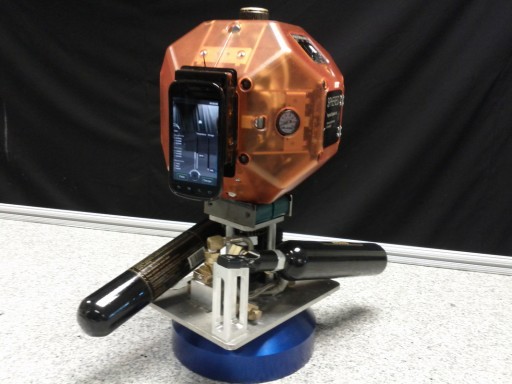Smart SPHERES

Smart-SPHERES is a free-flying ‘space robot’ that uses technology from NASA’s SPHERES project (Synchronized Position Hold, Engage, Reorient Experimental Satellites) that has been in progress aboard ISS since 2003 using miniature satellites inside the Station to demonstrate formation flying, docking and tele-operations.
The bowling-ball sized satellites feature a cold gas propulsion system to be able to move autonomously as commanded by their control systems that include attitude and acceleration sensors as well as a communications system to be able to exchange data with its counterparts and ISS systems. Each SPHERES satellite is an 18-sided polyhedron, 0.2 meters in diameter with a mass of 3.5 Kilograms.
Smart SPHERES experiments began in 2011 as the first of three SPHERES satellites was outfitted with a smartphone to use it to take photos and make calculations that can be transmitted via the Station’s WiFi in real time. Over the course of SPHERES testing, the satellites completed more complex exercises and were also re-purposed for other tests such as the study of fluid dynamics in a simulated fuel tank of a spacecraft or upper stage.
Being launched on Cygnus Orb-2 is the latest upgrade that will be made to the SPHERES to make them even smarter – a Project Tango prototype Android smartphone developed by Google’s Advanced Technology and Projects division. The prototype includes a custom-3D sensor which allows the device to track its own position and orientation in real time while also gathering a 3D model of its environment.
The 3D sensor will become the centerpiece in the satellite’s navigation system, making their navigation algorithms more precise when the satellites are flying around the interior of the space station.
For the long run, robots like SPHERES are envisioned to be flying through the interior and around the exterior of the space station to complete inspections and monitoring tasks with a variety of sensors (imagers, IR sensors, radiation dosimeters). Initial 3D runs using SPHERES will be performed later in 2014 to validate the software of SPHERES and the smartphone, optimizing the interplay between the two ahead of more advanced tasks.
